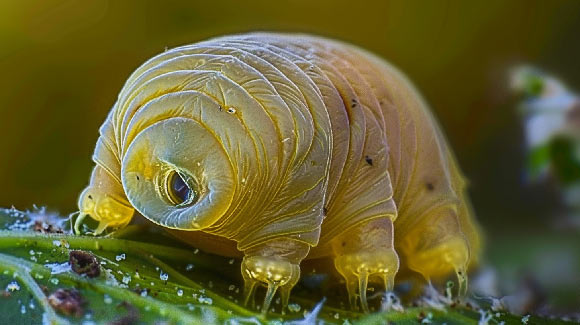Tardigrades can survive remarkable doses of ionizing radiation, up to about 1,000 times the lethal dose for humans. How they do so is incompletely understood. In a new study, scientists from the University of North Carolina found that a tardigrade species called Hypsibius exemplaris suffers DNA damage upon gamma irradiation, but the damage is repaired. The study shows that this species has a specific and robust response to ionizing radiation: irradiation induces a rapid upregulation of many DNA repair genes.
First discovered in 1773, tardigrades are a diverse group of microscopic invertebrates famous for their ability to withstand extreme conditions.
Also known as water bears or moss piglets, they can live for up to 60 years, and grow to a maximum size of 0.5 mm, best seen under a microscope.
Tardigrades are able to survive for up to 30 years without food or water, for a few minutes at temperatures as low as minus 272 degrees Celsius (minus 457 degrees Fahrenheit) or as high as 150 degrees Celsius (302 degrees Fahrenheit), and minus 20 degrees Celsius (minus 4 degrees Fahrenheit) for decades.
They withstand pressures from virtually 0 atm in space up to 1,200 atm at the bottom of the Marianas Trench.
They are also resistant to radiation levels up to 5,000-6,200 Gy.
“What we saw surprised us. The tardigrades are doing something we hadn’t expected,” said Professor Bob Goldstein, a researcher at the University of North Carolina at Chapel Hill.
In their research, Professor Goldstein and his colleagues examine how Hypsibius exemplaris tardigrades can survive intense radiation.
They found that the species is not immune to DNA damage — irradiation does damage their DNA — but the tardigrades can repair extensive damage.
They were surprised to find that the tardigrades can increase the volume of production from DNA repair genes.
Unlike humans, they can ramp up the level of DNA repair genes’ products to such an extreme extent that they become some of the most abundant gene products in animals.
“These animals are mounting an incredible response to radiation, and that seems to be a secret to their extreme survival abilities,” said Dr. Courtney Clark-Hachtel, a researcher at the University of North Carolina at Asheville.
“What we are learning about how tardigrades overcome radiation stress can lead to new ideas about how we might try to protect other animals and microorganisms from damaging radiation.”
The findings appear in the journal Current Biology.
_____
Courtney M. Clark-Hachtel et al. The tardigrade Hypsibius exemplaris dramatically upregulates DNA repair pathway genes in response to ionizing radiation. Current Biology, published online April 12, 2024; doi: 10.1016/j.cub.2024.03.019


